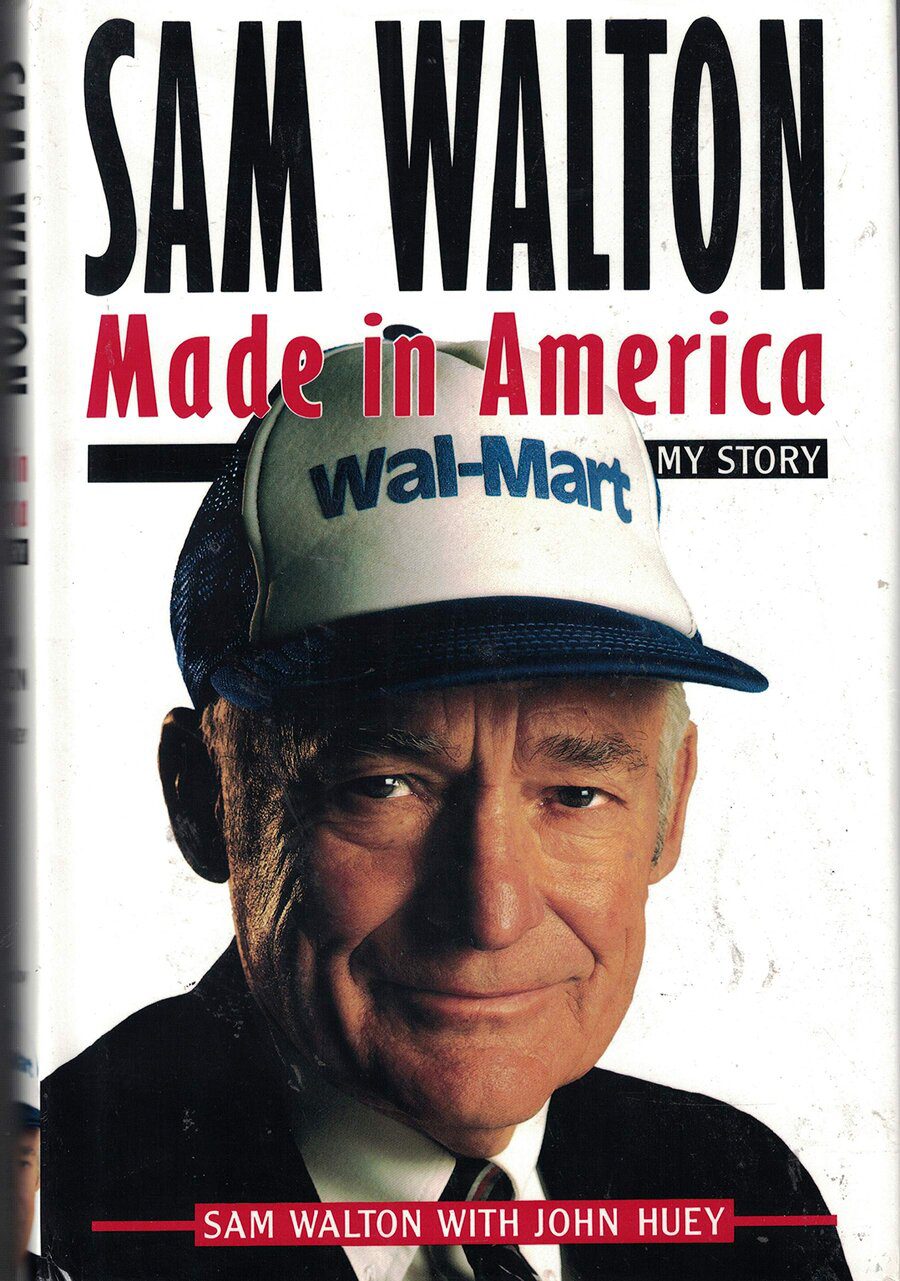“With the possible exception of Henry Ford, Sam Walton is the entrepreneur of the century.”- TOM PETERS, co-author of In Search of Excellence
Print | Kindle(eBook) | Audiobook
Made In America is the story of how Sam Walton built a retailing empire, “Walmart” from a humble upbringing. He started it from a single dime store in a hardscrabble cotton town (Arkansas) into the largest retailer in the world. In a story rich with anecdotes and the “rules of the road” of both Main Street and Wall Street, Sam Walton chronicles the inspiration, heart, and optimism that propelled him to lasso the American Dream.
Wal-Mart Stores Inc. grew to be the world’s largest corporation by revenue and the biggest private employer in the world. For a while, Walton was the richest man in America. As of July 31, 2020, Walmart has 11,496 stores and clubs in 27 countries, operating under 56 different names.
I think it must be human nature that when somebody homegrown gets on to something, the folks around them sometimes are the last to recognize it.
The company which Sam built Walmart is the world’s largest company by revenue, with US$514.405 billion, according to the Fortune Global 500 list in 2019. It is also the largest private employer in the world, with 2.2 million employees. It is a publicly-traded family-owned business, as the Walton family controls the company. Sam Walton’s heirs own over 50 percent of Walmart by holding company Walton Enterprises and their holdings.
Sam Walton was a relentless, hands on entrepreneur who led by example. In his own words:
I don’t know that anybody else has ever done it quite like me: started out as a pure neophyte, learned his trade, swept the floor, kept the books, trimmed the windows, weighed the candy, rung the cash register, installed the fixtures, remodeled the stores, built an organization of this size and quality, and kept on doing it right up to the end because they enjoyed it so much. No one that I know of has done it that way.
Here are my favourite take aways from reading,Made In America by Sam Walton:
In 1945, after leaving the military, Walton took over the management of his first variety store at the age of 26. With the help of a $20,000 loan from his father-in-law, plus $5,000 he had saved from his time in the Army, Walton purchased a Ben Franklin variety store in Newport, Arkansas. The store was a franchise of the Butler Brothers chain.
Growth Trajectory
- 1960—STORES 9—SALES $1.4 million –PROFITS $112,000
- 1970—STORES 32–SALES $31 million –PROFITS $1.2 million
- 1980—STORES 276—SALES $1.2 billion –PROFITS $41 million
- 1990—STORES 1,528–SALES $26 billion–PROFITS $1 billion
There’s always a challenger coming along. There may be one on the street right now formulating a plan to get to the top. To stay ahead of those challengers, we have to keep changing and looking back over our shoulders and planning ahead.
Lead by Example
Sam Walton
- “A lot of people think it’s crazy of me to fly coach whenever I go on a commercial flight, and maybe I do overdo it a little bit. But I feel like it’s up to me as a leader to set an example. It’s not fair for me to ride one way and ask everybody else to ride another way. The minute you do that, you start building resentment and your whole team idea begins to strain at the seams.”
There’s nothing at all profound about any of our principles. In fact, they’re all common sense, and most of them can be found in any number of books or articles on management theory—many of which I’ve read and studied over the years. But I think the way we’ve applied them at Wal-Mart has been just a little different.
Close Proximity Syndrome
- “It was always interesting to me that, except for those folks who worked in our company, our stock got very little support early on from the folks right here in northwest Arkansas. I always had the feeling that the people around here who remembered us when we had one store and three stores, or remembered me when I was president of the Rotary or the Chamber of Commerce, somehow thought we were doing it with mirrors.
- They couldn’t help but think we were just lucky, that we could not continue long term to do as well as we have done. I don’t think it was anything peculiar to this part of the country or me or anything like that. I think it must be human nature that when somebody homegrown gets on to something, the folks around them sometimes are the last to recognize it.
Sam Walton’s Rules for Building a Business
RULE 1: COMMIT to your business.
Believe in it more than anybody else. I think I overcame every single one of my personal shortcomings by the sheer passion I brought to my work. I don’t know if you’re born with this kind of passion, or if you can learn it. But I do know you need it. If you love your work, you’ll be out there every day trying to do it the best you possibly can, and pretty soon everybody around will catch the passion from you —like a fever.
RULE 2: SHARE your profits with all your associates, and treat them as partners.
In turn, they will treat you as a partner, and together you will all perform beyond your wildest expectations. Remain a corporation and retain control if you like, but behave as a servant leader in a partnership. Encourage your associates to hold a stake in the company. Offer discounted stock, and grant them stock for their retirement. It’s the single best thing we ever did.”
RULE 3: MOTIVATE your partners.
Money and ownership alone aren’t enough. Constantly, day by day, think of new and more interesting ways to motivate and challenge your partners. Set high goals, encourage competition, and then keep score. Make bets with outrageous payoffs. If things get stale, cross-pollinate; have managers switch jobs with one another to stay challenged. Keep everybody guessing as to what your next trick is going to be. Don’t become too predictable.
RULE 4: COMMUNICATE everything you possibly can to your partners.
The more they know, the more they’ll understand. The more they understand, the more they’ll care. Once they care, there’s no stopping them. If you don’t trust your associates to know what’s going on, they’ll know you don’t really consider them partners. Information is power, and the gain you get from empowering your associates more than offsets the risk of informing your competitors.”
“RULE 5: APPRECIATE everything your associates do for the business.
A paycheck and a stock option will buy one kind of loyalty. But all of us like to be told how much somebody appreciates what we do for them. We like to hear it often, and especially when we have done something we’re really proud of. Nothing else can quite substitute for a few well-chosen, well-timed, sincere words of praise. They’re absolutely free—and worth a fortune.”
“RULE 6: CELEBRATE your successes.
Find some humor in your failures. Don’t take yourself so seriously. Loosen up, and everybody around you will loosen up. Have fun. Show enthusiasm—always. When all else fails, put on a costume and sing a silly song. Then make everybody else sing with you. Don’t do a hula on Wall Street. It’s been done. Think up your own stunt. All of this is more important, and more fun, than you think, and it really fools the competition. “Why should we take those cornballs at Wal-Mart seriously?”
RULE 7: LISTEN to everyone in your company.
And figure out ways to get them talking. The folks on the front lines—the ones who actually talk to the customer—are the only ones who really know what’s going on out there. You’d better find out what they know. This really is what total quality is all about. To push responsibility down in your organization, and to force good ideas to bubble up within it, you must listen to what your associates are trying to tell you.
RULE 8: EXCEED your customers’ expectations.
If you do, they’ll come back over and over. Give them what they want—and a little more. Let them know you appreciate them. Make good on all your mistakes, and don’t make excuses—apologize. Stand behind everything you do. The two most important words I ever wrote were on that first Wal-Mart sign: “Satisfaction Guaranteed.” They’re still up there, and they have made all the difference.
RULE 9: CONTROL your expenses better than your competition. This is where you can always find the competitive advantage. For twenty-five years running—long before Wal-Mart was known as the nation’s largest retailer—we ranked number one in our industry for the lowest ratio of expenses to sales. You can make a lot of different mistakes and still recover if you run an efficient operation. Or you can be brilliant and still go out of business if you’re too inefficient.”
“RULE 10: SWIM upstream.
Go the other way. Ignore the conventional wisdom. If everybody else is doing it one way, there’s a good chance you can find your niche by going in exactly the opposite direction. But be prepared for a lot of folks to wave you down and tell you you’re headed the wrong way. I guess in all my years, what I heard more often than anything was: a town of less than 50,000 population cannot support a discount store for very long.”
“I believe that every right implies a responsibility; every opportunity an obligation; every possession a duty.”—JOHN D. ROCKEFELLER, JR.”
Enlightened Self-Interest;
- Sam Walton: “We’ve been able to help our associates to a greater degree than most companies because of what you’d have to call enlightened self-interest; we were selfish enough to see in the beginning the value to the company of letting them share the profits.”
Appreciation
- “Keeping so many people motivated to do the best job possible involves a lot of the different programs and approaches we’ve developed at Wal-Mart over the years, but none of them would work at all without one simple thing that puts it all together: appreciation. All of us like praise. So what we try to practice in our company is to look for things to praise. Look for things that are going right. We want to let our folks know when they are doing something outstanding, and let them know they are important to us.”
- “You can’t praise something that’s not done well. You can’t be insincere. You have to follow up on things that aren’t done well. There is no substitute for being honest with someone and letting them know they didn’t do a good job. All of us profit from being corrected—if we’re corrected in a positive way. But there’s no better way to keep someone doing things the right way than by letting him or her know how much you appreciate their performance. If you do that one simple thing, human nature will take it from there.”
Hiring
- “If you take someone who lacks the experience and the know-how but has the real desire and the willingness to work his tail off to get the job done, he’ll make up for what he lacks. And that proved true nine times out of ten. It was one way we were able to grow so fast.”
Hire Smart People
- “I was really surrounding myself with guys who were good at all the things I tended to just sluff off, like organizing the company to handle the growth explosion we had started. If I hadn’t gone after those folks, and kept on doing it, we would have come apart somewhere there in the seventies, or we certainly wouldn’t have been able to pull off our really incredible expansion in the eighties. Getting an early start on all these systems, building a foundation for our distribution center development, starting to put data processing into the stores, really saved our bacon later on.”
On Competition
- “Our competitors have honed and sharpened us to an edge we wouldn’t have without them. We wouldn’t be nearly as good as we are today without Kmart, and I think they would admit we’ve made them a better retailer. One reason Sears fell so far off the pace is that they wouldn’t admit for the longest time that Wal-Mart and Kmart were their real competition. They ignored both of us, and we both blew right by them.”
On the Media
- “When you start out as an unknown quantity with just a dream and a commitment, you couldn’t buy a mention of your company in one of these publications. When you become moderately successful, they still ignore you unless something bad happens to you. Then, the more successful you become, the more suspicious they become of you. And if you ever become a large-scale success, it’s Katie bar the door. Suddenly, you make a very convenient villain because everybody seems to love shooting at who’s on top.”
Competing with Walmart
- “Unless small merchants are already doing a great job, they’ll probably have to rethink their merchandising and advertising and promotional programs once a discounter arrives on the scene. They need to avoid coming at us head-on and do their own thing better than we do ours. It doesn’t make any sense to try to underprice Wal-Mart on something like toothpaste. That’s not what the customer is looking to a small store for anyway.
- “Most independents are best off, I think, doing what I prided myself on doing for so many years as a storekeeper: getting out on the floor and meeting every one of the customers. Let them know how much you appreciate them, and ring that cash register yourself. That little personal touch is so important for an independent merchant because no matter how hard Wal-Mart tries to duplicate it—and we try awfully hard —we can’t really do it.”
Think One Store at a Time – Sam Walton :
- “That sounds easy enough, but it’s something we’ve constantly had to stay on top of. Because our sales and earnings keep going up doesn’t mean that we’re smarter than everyone else, or that we can make it happen because we’re so big.”
- “What it means is that our customers are supporting us. If they stopped, our earnings would simply disappear, and we’d all be out looking for new jobs. So we know what we have to do: keep lowering our prices, keep improving our service, and keep making things better for the folks who shop in our stores. That is not something we can simply do in some general way. It isn’t something we can command from the executive offices because we want it to happen. We have to do it store by store, department by department, customer by customer, associate by associate”
On Non-Profits – Sam Walton
- “We’re not satisfied that the traditional methods by which charitable foundations are operated really meet our criteria. Some people have crowed a great deal about all their philanthropy over the years, but too many of these foundations, I suspect, were only begun as tax shelters without much real sense of purpose.”
- “Many of them seem to have become very nice places to work for a small group of folks who have built up pretty thick crusts of administration and bureaucracy. Those are two of the things we have fought the hardest to keep out of our company, so naturally, we don’t want them clogging up our nonprofit efforts.”
All the best in your quest to get better. Don’t Settle: Liver with Passion.



2 Comments
Pingback: Every Wall is a Door. – Lanre Dahunsi
Pingback: Who Luck – The Power of Proximity. – Lanre Dahunsi